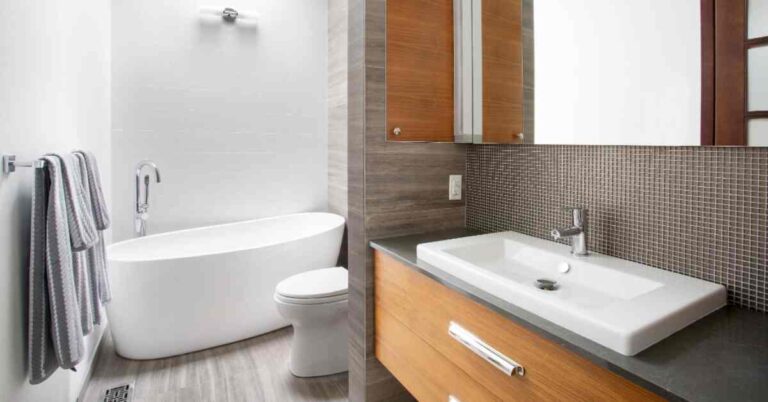Ah, bathrooms—the oasis where we start and end our days. A bathroom remodel can completely transform the look and feel of your home. But amidst all the home design and decorating excitement, one important aspect often gets overlooked: the flooring. Yes, the flooring in your bathroom plays a crucial role in both functionality and aesthetics.
In this ultimate guide, we’ll dive into bathroom flooring options. We’ll explore the unique challenges of bathroom flooring, factors to consider when choosing the best flooring, and the different types available. We’ll even shed some light on eco-friendly and sustainable flooring choices. So, let’s get started!
Understanding the Importance of Bathroom Flooring
Bathrooms are unique spaces with their own set of challenges regarding flooring. Before diving into the different flooring options, let’s understand why choosing the right flooring is important. Here are a couple of key considerations:
Water Exposure and Moisture Concerns
Water-resistant flooring is essential in bathrooms because they are prone to frequent water exposure. From showers to sinks, moisture is everywhere. Choosing flooring that can withstand water and prevent damage is crucial to avoid swelling, warping, and mold development. Nobody wants their bathroom to turn into a breeding ground for mold and mildew!
Slip-Resistance and Safety Considerations
Bathrooms can be slippery, especially when wet. Choosing slip-resistant flooring is vital to ensure your safety and prevent accidents. Nobody wants to experience an unintentional dance routine while trying to brush their teeth!
When selecting bathroom flooring, keep these factors in mind to create a space that is not only beautiful but also safe and durable.
Types of Bathroom Flooring Options
Now that we understand the importance of bathroom flooring, let’s explore the various options available. Each flooring type has advantages, disadvantages, and suitability for different applications. Here are some popular choices:
Ceramic and Porcelain Tiles
- Advantages: Durable, water-resistant, wide range of design possibilities
- Disadvantages: Cold to the touch, can be slippery when wet
- Suitable Applications: Kitchens, basements, laundry, and mudrooms
- Maintenance and Care Tips: Regular cleaning with non-abrasive cleaners
Vinyl Flooring
- Advantages: Water-resistant, comfortable underfoot, budget-friendly
- Disadvantages: Prone to scratches and dents, may require full replacement
- Waterproof flooring options are available
- Maintenance and Care Tips: Sweep regularly and mop with a vinyl floor cleaner
Laminate Flooring
- Advantages: Affordable, easy to install, wide range of design options
- Disadvantages: Not fully waterproof, can swell and warp with moisture
- Water-resistant flooring options are available
- Maintenance and Care Tips: Avoid excessive moisture and clean with a damp mop
Natural Stone Flooring
- Advantages: Timeless beauty, unique variations, add value to your home
- Disadvantages: Requires sealing, can be cold and slippery
- Suitable Applications: Bathrooms, entryways, living areas
- Maintenance and Care Tips: Regular sealing and cleaning with stone-specific products
Engineered Wood Flooring
- Advantages: Resembles hardwood, water-resistant options available
- Disadvantages: Not fully waterproof, can swell and warp with moisture
- Suitable Applications: Bathrooms, kitchens, living areas
- Maintenance and Care Tips: Wipe up spills promptly and avoid excessive moisture
Remember, the key to choosing the right flooring for your bathroom is to consider your specific needs, budget, and design preferences.
Eco-Friendly and Sustainable Bathroom Flooring Options
If you’re passionate about sustainability and want to make eco-friendly choices, you have plenty of options. Here are some eco-friendly and sustainable bathroom flooring options to consider:
Bamboo Flooring
- Advantages: Renewable resources, durable, water-resistant options available
- Disadvantages: May scratch easily, requires proper sealing
- Sustainable sourcing and certifications available
- Maintenance and Care Tips: Regular sweeping and damp mopping
Cork Flooring
- Advantages: Renewable, soft, and comfortable underfoot, naturally resistant to mold and mildew
- Disadvantages: Can be prone to scratches and dents, requires sealing
- Renewable and recyclable properties
- Maintenance and Care Tips: Avoid excessive moisture and clean with a damp mop
Recycled Tile and Glass Flooring
- Advantages: Utilizes recycled materials, unique and creative design possibilities
- Disadvantages: Limited availability, can be expensive
- Maintenance and Care Tips: Follow the manufacturer’s recommendations for cleaning and maintenance
Factors to Consider When Choosing Bathroom Flooring
When choosing the best bathroom flooring, there are several factors to consider. Let’s take a closer look at these considerations:
Water Resistance and Durability
As mentioned earlier, water resistance is crucial for bathroom flooring. Look for flooring materials that can withstand water exposure without warping or developing mold and mildew. Additionally, consider the durability of the flooring, as bathrooms experience high foot traffic and frequent use.
Slip-Resistance and Safety
Ensure your flooring is slip-resistant to prevent accidents, especially in wet conditions. Look for flooring options with textured surfaces or coatings that provide better traction.
Maintenance and Cleaning
Consider the maintenance and cleaning requirements of each flooring option. Some materials may require special cleaning products or regular sealing to maintain their appearance and durability. Choose flooring that aligns with your maintenance preferences and lifestyle.
Budget and Cost
Set a budget for your bathroom flooring project and explore options within that range. Remember that some materials may have higher upfront costs but offer long-term durability, reducing the need for replacement or repairs in the future.
Aesthetics and Design
Finally, consider the overall look and design of your bathroom. Choose flooring that complements your desired aesthetic, whether a sleek and modern style or a cozy and rustic vibe. Consider each flooring material’s color, texture, and pattern options.
By considering these factors, you can make an informed decision and choose the best flooring option for your bathroom.
Conclusion
Choosing the right flooring for your bathroom is a critical decision that combines functionality, aesthetics, and personal preferences. You can make an informed choice by understanding the unique challenges of bathroom flooring, exploring the various options available, and considering factors like water resistance, slip resistance, and maintenance requirements.
Remember, whether you opt for ceramic tiles, vinyl, laminate, natural stone, or eco-friendly options like bamboo or cork, your bathroom flooring should be durable, safe, and visually pleasing. So transform your bathroom into a space that reflects your style and stands the test of time!
Frequently Asked Questions
The different types of bathroom flooring include ceramic tile, vinyl, laminate, natural stone, and waterproof engineered wood.
When choosing bathroom flooring, consider water resistance, durability, maintenance requirements, slip resistance, and aesthetic appeal.
To maintain and clean bathroom flooring, regularly sweep or vacuum to remove debris, mop with a mild cleaning solution, and avoid using harsh chemicals or abrasive tools. Promptly clean up any spills or stains to prevent damage.
Yes, depending on the type of flooring, you can install bathroom flooring yourself. However, consulting professional installers for complex materials like natural stone or if you have limited DIY experience is recommended.
The lifespan of bathroom flooring varies depending on the material. With proper maintenance, ceramic tile and natural stone can last for decades, while vinyl and laminate flooring typically last around 10-20 years.


